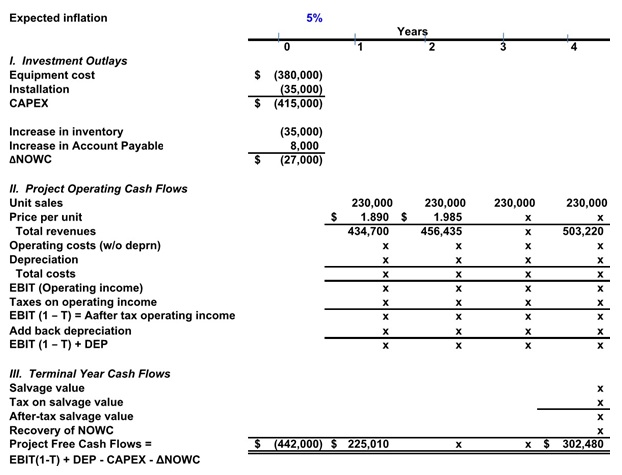MGMT6016 Financial Management Case Study Solutions on Allied Food Products
Are you looking for MGMT6016 Allied Food Products: Financial Management Case Study Assignment Answers? Assignmenthelpaus.com provides Financial Management Assignment Help at a cost-effective price. Our MBA writers assist you with case study writing help. We have a huge team of experienced writers who provides students plagiarism free work.
Assignment Details:-
- Topic: Financial Management
- Subject: Human Resource
- Words: 2500
- Citation/Referencing Style: MLA
Allied Food Products is considering expanding into the fruit juice business with a new fresh lemon juice product. Assume that you were recently hired as assistant to the director of capital budgeting, and you must evaluate the new project.
The lemon juice would be produced in an unused building adjacent to Allied’s Fort Myers plant; Allied owns the building, which is fully depreciated. The required equipment would cost $380,000, plus an additional $35,000 for shipping and installation. In addition, inventories would rise by $35,000, while accounts payable would increase by $8,000. All of these costs would be incurred at t = 0. By a special ruling, the machinery could be depreciated under the MACRS system as 4-year property. The applicable depreciation rates are 35%, 30%, 25%, and 10%.
The project is expected to operate for 4 years, at which time it will be terminated. The cash inflows are assumed to begin 1 year after the project is undertaken (t = 1), and to continue out to t = 4. At the end of the project’s life (t = 4), the equipment is expected to have a salvage value of $40,000.
Unit sales are expected to total 230,000 units per year, and the expected sales price is $1.80 per unit. Cash operating costs for the project (total operating costs less depreciation) are expected to total 45% of dollar sales. Allied’s tax rate is 15%, and its WACC is 10%. Tentatively, the lemon juice project is assumed to be of equal risk to Allied’s other assets.
You have been asked to evaluate the project and to make a recommendation as to whether it should be accepted or rejected. To guide you in your analysis, your boss gave you the following set of tasks/questions:
Part (A)
Allied has a standard form that is used in the capital budgeting process. (See Table 1) Part of the table has been completed, but you must replace the blanks with the missing numbers (marked with x).
Complete the table using the following steps:
- Fill in the blanks under Year 0 for the initial investment outlays: Capital Expenditures (CAPEX) and change in Net Operating Working Capital (ΔNOWC).
- Complete the table for unit sales, sales price, total revenues, and operating costs excluding depreciation.
- Complete the depreciation data.
- Complete the table down to after-tax operating income and then down to the project’s operating cash flows, EBIT(1 − T) + DEP.
- Fill in the blanks under Year 4 for the terminal cash flows and complete the project free cash flow line.
Table 1: Allied’s Lemon Juice Project
Part (B)
Calculate the project’s NPV, IRR, MIRR, and payback. Do these indicators suggest that the project should be accepted? Explain.
Part (C)
- What is sensitivity analysis?
- Perform a sensitivity analysis on the unit sales, salvage value, and WACC for the project. Assume that each of these variables deviates from its base-case, or expected value by plus or minus 10%, 20%, and 30%. Calculate NPV for each case (21 NPV in total: 7 NPV for change in unit sale; 7 NPV for change in salvage value; and 7 NPV for change in WACC), then draw a graph with three lines (one for Unit Sales, one for Salvage Value, and one for WACC, all three lines in the same graph). At the end, perform a sensitivity analysis for the project (what you have seen from your graph, what conclusion you can make?).
- What is the primary weakness of sensitivity analysis? What are its primary advantages?
Part (D)
Assume that inflation is expected to average 5% over the next 4 years and that this expectation is reflected in the WACC. Moreover, inflation is expected to increase revenues and variable costs by this same 5%. Does it appear that inflation has been dealt with properly in the initial analysis to this point? If not, what should be done and how would the required adjustment affect the decision?
Table 2: Allied’s Lemon Juice Project Considering 5% Inflation
Part (E)
Assume that you are confident about the estimates of all the variables that affect the cash flows except unit sales. If product acceptance is poor, sales would be only 80,000 units a year, while a strong consumer response would produce sales of 250,000 units. In either case, cash costs would still amount to 45% of revenues. You believe that there is a 35% chance of poor acceptance, a 15% chance of excellent acceptance, and a 50% chance of average acceptance (the base case).
- What is the worst-case NPV? The best-case NPV? Hint: you should consider the 5% inflation in your
- Use the worst-case, most likely case (or base-case), and best-case NPVs with their probabilities of occurrence, to find the project’s expected NPV, standard deviation, and coefficient of variation.
Part (F)
Assume that Allied’s average project has a coefficient of variation (CV) in the range of 1.05 to 1.75. Would the lemon juice project be classified as high risk, average risk, or low risk? What type of risk is being measured here?
For REF… Use: #getanswers2001875



